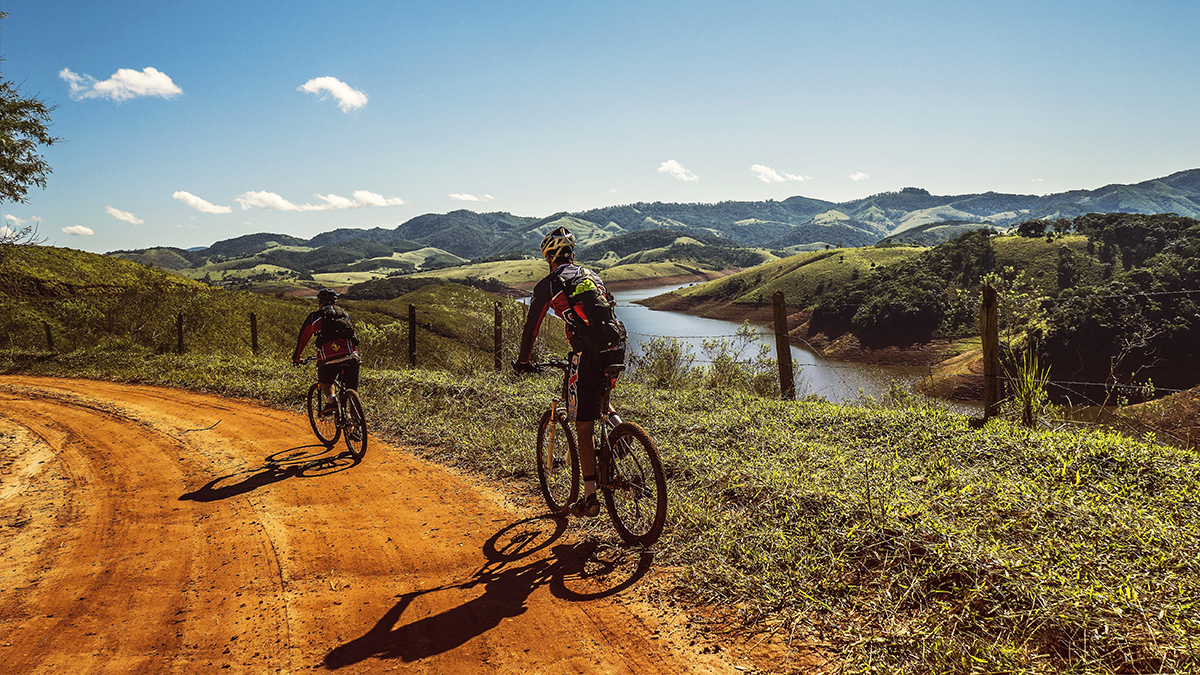Adventure sports can be a great way to explore the great outdoors while engaging in physical activity and doing something competitive.
There are so many different adventure sports to choose from. Below are just some of the best adventure sports for those that love to travel and immerse oneself in the natural world.
Hiking
Hiking involves going on long, physically challenging walks. It typically involves hiking along specific routes known as ‘trails’, although you can create your own routes (in many parts of the world, trails tend to be a safer option). Specific types of hiking include mountaineering, snowshoeing, waterfalling and swim hiking.
Hiking is a great form of cardio exercise and can also build muscle in the legs and core. You can even build upper body strength by carrying heavy loads. Beyond its physical benefits, it’s a great way of exploring the wilderness, including accessing locations that may only be accessible by foot such as Machu Picchu and the peak of Kilimanjaro.
When getting into hiking, it’s worth investing in some hiking boots to protect your feet. Some people also buy poles, but they’re not always necessary. Dressing appropriately is important – especially when climbing mountains for hiking in cold weather. You can then start by looking into local trails and build your way up to more challenging walks.
Mountain biking
Unlike regular biking which takes place on a road, mountain biking is a chance to go off-road. This doesn’t just include mountains, but also deserts and forests and hills. There are different types of mountain biking that you can get into ranging from cross-country to downhill (often via specific summer downhill trails at ski resorts).
Mountain biking is great for the legs and the core, and is also a great cardio workout. While you may not be able to access all the same locations that you can when hiking, you can still explore some incredible places and cover more ground in a day. Plus, the speed and jumps may appeal to thrillseekers.
The most important thing you’ll need to get into mountain biking is of course a mountain bike. A helmet and appropriate cycle gear are also recommended. As with hiking, it’s best to start locally and venture further afield when you’ve built up your confidence.
Skiing/Snowboarding
Snow sports like skiing and snowboarding are typically practiced at ski resorts. Skiers and snowboarders take on runs that are color-coded to signify their difficulty. There’s also the option of going off-piste. Several variations of these snow sports exist ranging from cross-country skiing to freestyle snowboarding.
Skiing and snowboarding both target different muscles, however both do target the core and are cardio exercises. The thrill of traveling at speed down a mountain in the snow is the big pull factor, however the magnificent scenery is also part of the appeal. Oh, and there’s the apres-ski culture too!
Most beginners will hire skis or a snowboard while at a resort. It’s beneficial to take lessons, although some people are self-taught. Once you get more confident and skilled, you can then consider buying your own gear. Make sure to wrap up warm – this guide at OnTheSnow offers more tips on what to wear.
Horse Riding
Horses used to be a major form of transport. Nowadays, horse-riding is more of a hobby. Much of the horse riding sport is carried out in indoor rings, arenas or designated race tracks. However, horse-riding can also be a form of exploration – there are many designated horse-riding trails around the world that can allow you to explore everything from the Torres del Paine to Turkey’s Cappadocia.
Horse riding is more of a workout than many people realize – the horse may be doing much of the work, but there’s still a fair amount of cardio and core exercising required to keep one’s balance and control the horse. From a saddle, you can also take in some incredible views that you may not always get from hiking or cycling.
You can go on horse riding tours, rent a horse or ride your own horse. The latter is only advisable if you’ve had lots of experience with horses, as they are expensive and high-maintenance pets. Riding schools can teach you how to ride a horse. You can rent much of the equipment here, and buy your own gear once you develop your passion.
Rock Climbing/Abseiling
There are two ways to scale a cliff: ‘rock climbing’ which involves climbing up, or ‘abseiling’ (rappelling) which involves descending on a rope. While artificial climbing walls are the most common places to practice this sport, you can find many natural cliffs around the world where this sport is possible. Most people start accompanied by a climbing expert, and then build the confidence to try it on their own (some maniacs even do it without a rope, which is known as ‘free climbing’.). There are all kinds of variations of this sport including ice climbing, coasteering and canyoning.
This sport is great for building arm and length strength, as well as flexibility and grip. It’s only suitable for those that like heights and is very much a thrillseeker sport. Of course, it can be a way of also reaching spectacular unique places ranging from high ledges to caves.
It’s best to ‘learn the ropes’ at a local artificial climbing wall. You can then try climbing in the great outdoors. You can usually hire much of the equipment. Once you get good at it, you may want to consider buying your own climbing equipment.
Fishing
Fishing for sport is very popular. This typically involves trying to catch large or rare fish in the wild. The most popular type of fishing is angling, which involves using a hook on a fishing rod – but there are other options like net fishing and spearfishing. Angling itself has many variations, including freshwater and saltwater angling. Examples of unique types of angling include canoe fishing, ice fishing and paddleboard fishing.
Fishing is typically not physically exertive, but it can still be very good for your physical health. It’s a chance to relax and spend time outdoors. There are many incredible locations to fish around the world where there is a great fishing culture. Many people also forget that fishing can be a form of hunting – while many people return the fish to the water, there is the option of catching fish to kill and eat.
You’ll need a rod to start fishing. Hiring a rod or buying one is an option. There are many blogs such as FishingKnowledgeHub where you can learn about fishing equipment, tactics and locations. Many people learn to fish from relatives, but you can also self-teach yourself or even take a course.
Fishing also gives you the opportunity to explore locales that you might not normally hit up when traveling. While beaches and coastal hikes might be the more popular ocean, finding some deep sea fishing at your destination gives you the opportunity to really experience the tranquility as well as the drama out on the open ocean. What’s more, it often gives you the opportunity to eat what you catch, helping you sample of the finest local delicacies, as fresh as you can get them.
Kayaking/Canoeing
Kayaking and canoeing are two forms of paddling. Whereas kayak uses two paddles, traditional canoeing uses one. Both kayaking and canoeing can be done solo, or with other people in the same boat. You can paddle in a river, a lake or in the sea.
Paddling is a full body workout – it exercises both the legs and the arms, while also serving as a cardio exercise. Of course, you can paddle at a more leisurely pace and turn it into a more relaxing activity. It is a great way to explore many places including coasts, canyons and even caves.
Most people hire a kayak or canoe and go on a guided tour. However, you can find your own routes. Buying a kayak or canoe is usually not necessary unless you do it regularly.
Rafting
Rafting uses a bigger boat than canoeing or kayaking. Such boats require multiple people to paddle them.
Rafting puts a bit more adrenaline into paddling as it’s usually done on rapids, although it can be done on calmer waters too. It can offer the opportunity to explore more rugged waters than you may be able to on a regular kayak. It’s also solely a group sport because of the size of the boat.
Most people go on rafting tours with a guide. A rafting license is required if you want to raft certain waters without a guide – especially if you’re taking other people and acting as ‘guide’. Hiring a boat is usually the way to go unless you start a rafting company.
Surfing
Surfing involves riding waves on a board. Most people start off by bodyboarding, and then graduate to standing up. It’s a sport that you can only really do by the coast – although there are some rivers and indoor pools with wave machines that do offer the opportunity to surf.
Surfing is a great cardio workout and a great core workout. It can also be a great source of thrills. You meanwhile get to spend all day in the sea. Like skiing, surfing also had a great culture surrounding it.
You can learn to surf at surf schools. Alternatively, you can try to teach yourself. Most surf schools have surfboards and wetsuits to hire. After time, you can then consider buying your own board and wetsuit. This guide at OutsideMagazine offers more tips for getting into surfing.
Paddleboarding
Paddleboarding is a combination between kayaking and surfing. It combines the paddle action of the former and the balance of the latter. Most people start paddleboarding on their knees and then learn to stand up. It is best practiced in relatively still water, but can be done in rougher water with the right board.
Paddleboarding is a good core workout. It’s also a great leisurely way to explore many places from the water (certainly more leisurely than surfing).
You can take paddleboarding lessons or teach yourself how to do it. There are places where you can hire the necessary equipment. Alternatively, you can buy your own paddle and board.
Open Water Swimming
Swimming in a river or the sea is often known as open water swimming. From competitive open water swimming to snorkeling, there are many forms of this swimming.
Swimming is a cardio sport that is also great for toning up muscles and burning calories. Open water swimming provides added benefits to swimming in a pool such as reducing muscle soreness and even being beneficial to your skin (particularly swimming in the sea). It can also be a form of exploration – there are some islands you can only access by swimming to, and you can also combine swimming with snorkeling to spot various marine wildlife.
You have to be careful as to where and when you swim. Pay attention to signs, consider the water temperature and consider the water flow before you get in. Some open water swimmers recommend gear such as a wetsuit, swimming cap and goggles before attempting this type of swimming, but it’s really personal preference.
Scuba Diving
Finally, there’s scuba diving. This is a form of swimming for those that want to venture below the surface. It is done while wearing breathing equipment (diving without this equipment is known as freediving as is a lot more dangerous).
Scuba diving can be a thrillseeker activity for some and a source of relaxation for others. It can also provide a workout. Of course, the biggest reason most people get into scuba diving is to explore underwater sights like reefs, shipwrecks and caves. Many of these sights cannot be explored as closely any other way.
In order to dive alone, you need to first obtain your PADI license. This is achieved by going to a diving school. Many people hire scuba diving equipment at first. You can then consider buying your own once you get the bug for it.
Global customers rely Bloomberg Sources to deliver accurate, real-time business and market-moving information that helps them make critical financial decisions please contact: michael@bloombergsources.com



